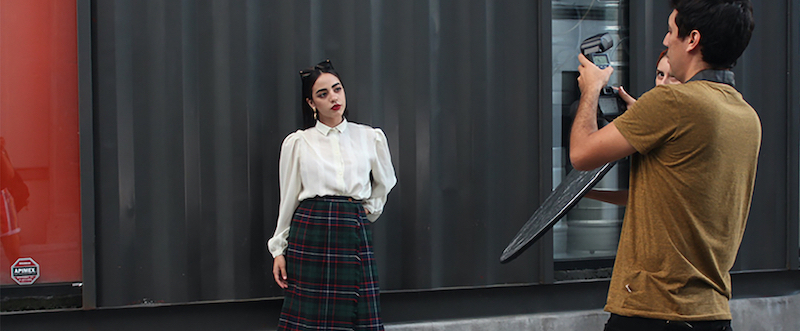"I Love It Very Much". The Intimate Relation with Garments. The Case of Thrift Fashion
DOI:
https://doi.org/10.29340/en.v4n7.163Keywords:
authenticity, style creation, thrift fashion, prosumer, vintageAbstract
This article explores the meanings and values given to clothing by women who enjoy a trend we call thrift. In order to capture such meanings and appraisals, we present explanations, narrations and images from exploratory work carried out with thrift clothing retailers and buyers in Monterrey. With the support of images and narrations, we analyze the interaction and the emotional links that retailers and buyers have with clothing. We explain the intimate relation with the garments and the verbal and visual expression of such links, as part of the effort that the thrift community makes to obtain authenticity in the framework of the creation and consumption of clothing.
Downloads
References
Abélès, Marc (2011). “Le portrait comme opérateur ethnographique: l’écriture et la vie (politique)”, en Josiane Massard-Vincent, Sylvaine Camelin y Christine Jungen, Le portrait, une proposition anthropographique, pp. 175-192. París: Éditions Petra.
Appadurai, Arjum (1991). “Introducción. Las mercancías y la política del valor”, en Arjum Appadurai (ed.), La vida social de las cosas. Perspectiva cultural de las mercancías , pp. 17 – 87. México: Grijalbo. Recuperado de http://designblog.uniandes.edu.co/blogs/dise2307/files/2014/10/Kopytoff-en-Appadurai.pdf, consultado el 09 de diciembre de 2020.
Barthes, Roland (1989). La cámara lúcida. Nota sobre la fotografía. Barcelona: Paidós.
Boticello, Julie (2012). “Between Classification, Objectification, and Perception: Processing Secondhand Clothing for Recycling and Reuse”, Textile, vol. 10, núm. 2, pp. 164-183. https://doi.org/10.2752/175183512X13315695424356 DOI: https://doi.org/10.2752/175183512X13315695424356
Canniford, Robin (2011). “A typology of Consumption Communities”, Research in Consumer Behavior, núm. 13, pp. 57-75. https://doi.org/10.1108/S0885-2111(2011)0000013007 DOI: https://doi.org/10.1108/S0885-2111(2011)0000013007
Catalani, Anna y Yupin Chung (2015). “Vintage or Fashion Clothes? An Investigation Inside the Issues of Collecting and Marketing Second-hand Clothes”, ResearchGate. Recuperado de https://www.researchgate.net/publication/268241629, consultado el 8 de marzo de 2019.
Cova, Bernard, Rovert V. Kozinets y Avi Shankar (2007). Consumer Tribes. Londres: Routledge.
Csikszenthmihalyi, Mihaly y Eugene Rochberg-Halton (1992). The Meaning of Things. Domestic Symbols and the Self. Cambridge: Cambridge University Press.
DeLong, Marilyn, Barbara Heinemann y Kathryn Reiley (2005). “Hooked on Vintage!”, Fashion Theory, vol. 9, núm. 1, pp, 23-42. https://doi.org/10.2752/136270405778051491 DOI: https://doi.org/10.2752/136270405778051491
Entwistle, Joanne (2002). El cuerpo y la moda. Una visión sociológica. Barcelona: Paidós.
Giddens, Anthony (2003). La constitución de la sociedad. Bases para la teoría de la estructuración. Buenos Aires: Amorrortu.
Hansen, Karen T. (2000). Salaula: The World of Secondhand Clothing and Zambia. Chicago: University of Chicago Press.
Harvey, David (2013). El enigma del capital y las crisis del capitalismo. Madrid: Akal.
Massard-Vincent, Josiane, Sylvaine Camelin y Christine Jungen (2011). “Le portrait, une proposition anthropographique”, en Josiane Massard-Vincent, Sylvaine Camelin y Christine Jungen, Portraits. Esquisses anthropographiques. París: Éditions Pétra.
McCracken, Grant (1986). “Culture and Consumption: A Theoretical Account of the Structure and Movement of the Cultural Meaning of Consumer Goods”, Journal of Consumer Research, vol. 13, núm. 1, pp. 71-84. https://doi.org/10.1086/209048 DOI: https://doi.org/10.1086/209048
Michael, Janna (2015) “It’s Really Not Hip to be a Hipster: Negotiating trends and autheticity in the cultural field”, Journal of Consumer Culture, vol. 15, núm. 2, pp. 163-182. https://doi.org/10.1177/1469540513493206 DOI: https://doi.org/10.1177/1469540513493206
Miller, Daniel (1987). Material culture and mass consumption. Oxford: Basil Blackwell.
Palmer, Alexandra y Hazel Clark (2005). Old Clothes, New Looks. Second Hand Fashion. Nueva York: Berg. https://doi.org/10.2752/9781847888815 DOI: https://doi.org/10.2752/9781847888815
Parsons, Elizabeth (2007). “Thompson’s Rubbish Theory: Exploring the Practices of Value Creation”, E-European Advances in Consumer Research, vol. 8, pp. 390-393. Recuperado de https://www.acrwebsite.org/volumes/13952/eacr/vol8/E-08, consultado el 9 de diciembre de 2020.
— (2005). “Dealing in Secondhand Goods: Creating Meaning and Value”, en E-European Advances in Consumer Research, vol. 7, pp. 189-194. Recuperado de https://www.acrwebsite.org/volumes/13770/eacr/vol7/E-07, consultado el 9 de diciembre de 2020.
Reiley, Kathryn y Marilyn DeLong (2011). “A Consumer Vision for Sustainable Fashion Practic”, Fashion Practice, vol. 3, núm. 1, pp. 61-83. https://doi.org/10.2752/175693811X12925927157054 DOI: https://doi.org/10.2752/175693811X12925927157054
Ritzer, George, y Nathan Jurgenson (2010). “Production, Consumption, Prosumption. The nature of capitalism in the age of the digital prosumer”, Journal of Consumer Culture, vol. 10, núm. 1, pp. 13-36. https://doi.org/10.1177/1469540509354673 DOI: https://doi.org/10.1177/1469540509354673
Stallybrass, Peter (1988). “Marx’s Coat”, en Patricia Spyer, Border Fetishisms: material objects in unstable spaces, pp. 183-207. Londres: Routledge.
Veenstra, Aleit y Giselinde Kuipers (2013). “It Is Not Old-Fashioned, It Is Vintage. Vintage Fashion and The Complexities of 21st Century Consumption Practices”, Sociology Compass, vol. 7, núm. 5, pp. 355-365. https://doi.org/10.1111/soc4.12033 DOI: https://doi.org/10.1111/soc4.12033

Published
Issue
Section
License
Copyright (c) 2021 Encartes

This work is licensed under a Creative Commons Attribution-NonCommercial 4.0 International License.
Aviso de derechos de autor
- Los autores/as conservan los derechos de autor y ceden a la revista el derecho a la primera publicación con el trabajo registrado con la licencia de atribución Creative Commons, que permite a terceros utilizar lo publicado siempre que mencionen la autoría del trabajo y a la primera publicación en esta revista
- Los autores/as pueden realizar otros acuerdos contractuales independientes y adicionales para la distribución no exclusiva de la versión del artículo publicado en esta revista (por ej. Incluirlo en un repositorio institucional o publicarlo en un libro) siempre que indiquen claramente que el trabajo se publicó por primera vez en esta revista.
El material puede ser copiado, distribuido, comunicado, ejecutado públicamente. Se pueden hacer obras derivadas de él. No se puede utilizar para fines comerciales. Se debe reconocer y citar la obra de la forma en que tú especifiques.









